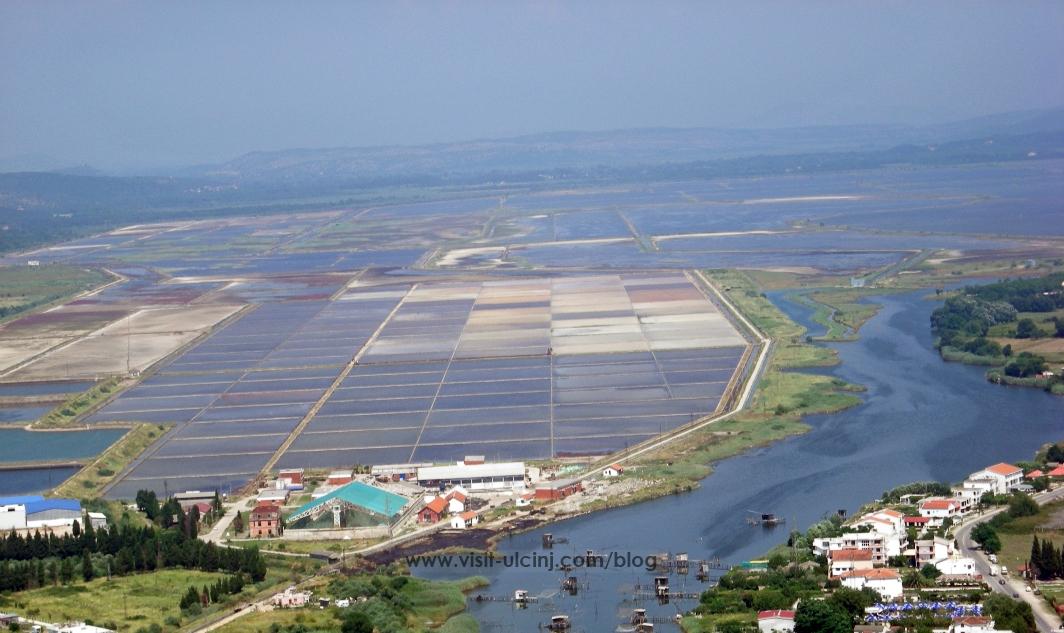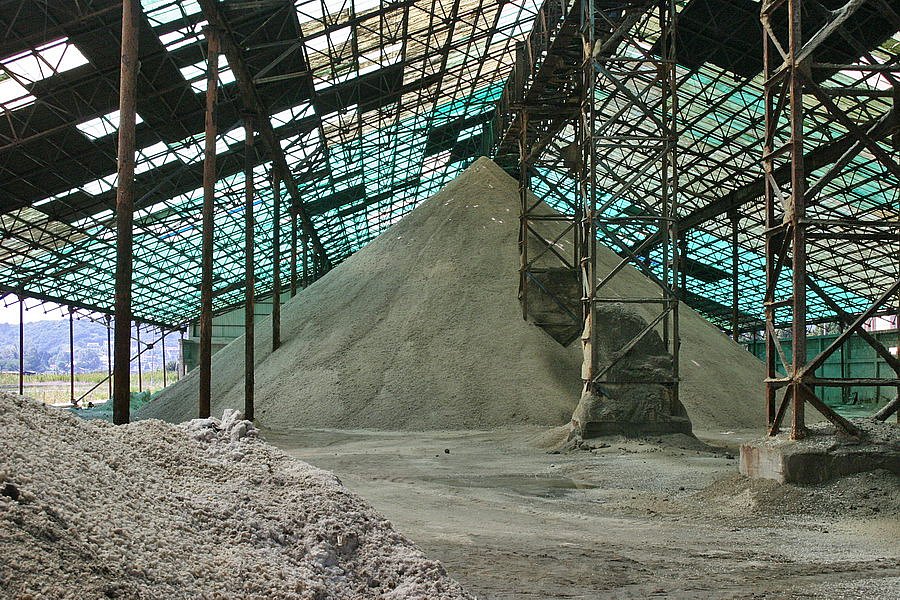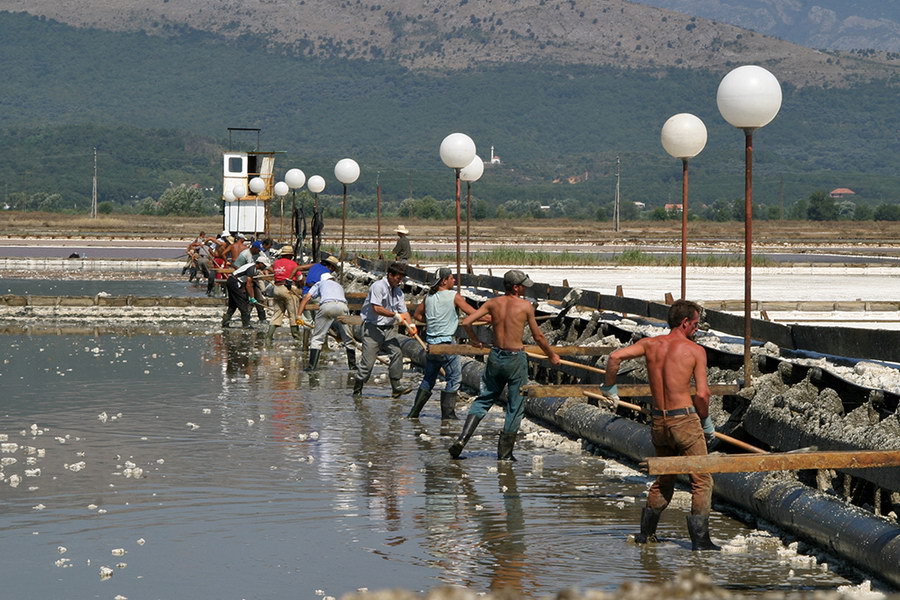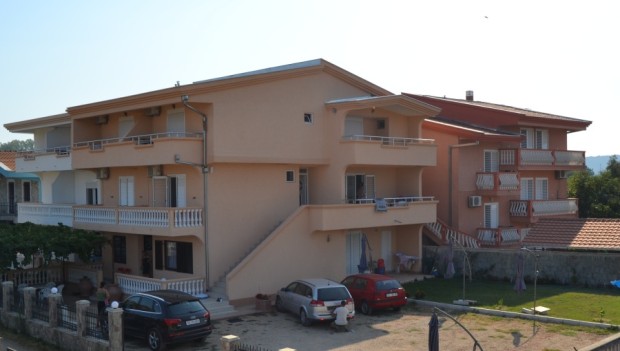 Translated by Aleksandar Gazivoda
Translated by Aleksandar Gazivoda
Salt work ŌĆ£Bajo SekulicŌĆØ (Solana Bajo Sekulic)
Salt work or Solana is the oldest company in Ulcinj.
It spreads on surface of 14.5km2.By its surface Solana is in the top 10 biggest salt works in Mediterranean. The beginning of Solana is related to hydro regulation of Zogaj mud in 1913 by digging drainage channel Port Milena. The earliest ponds were made in 1926-1934.By the half of XX century Solana was consequently added but it gained on the surface on early 80ŌĆÖ when it expended for 60% of itŌĆÖs total territory, so today it has 1492ha. Solana is surrounded by the channel which drainages the surrounding wetlands not allowing those waters to mix with waters prepared for salt work needs. Those channels drains the wetlands waters in to channel of Port Milena which flows in the sea.
Today Solana is artificially ecosystem, where are in advance determined periods of filing the ponds with sea water and their salinity. Solana is separated from Adriatic sea by embankments and from the River Bojana by drainage channel and additional embankments. Surface of Solana under the shallow salty water is 1883ha, while embankments and channels occupies 109ha.
Solana is one of the most important ornithological localities on Adriatic, and beyond, areas of international significance for birdŌĆÖs habitat.
All the area of Solana is backfilled with fine river depositŌĆÖs of organic origins and sand of inorganic components. Influence of the sea, existing salt production effects the soil to have basic reaction. On the bottom of the salt ponds in large deposits are found remains of shells.
The most important winter resorts and bird nesting on east coast of Adriatic is Solana.
First legal act of Solana protection is adopted in 1984, when with decision of the Workers Council is prohibited every kind of hunting. Some years later Solana becomes the first area of international significance for birds habitat in Montenegro , therefore Emerald habitat of Bern Convention. Solana is the first private park of nature in Montenegro.
MontenegroChronological history of Solana
1920-1926: Selection of preferable land sight for construction of Solana from Ankarna(Sloveny) to Ulcinj in Montenegro. It was chosen ZogajŌĆÖs lake in Ulcinj (which in Albanian language means the lake of birds) in delta of river Bojana.
1926-1934: Construction of first phase of Solana with required infrastructure buildings, equipment and evaporation ponds.
1935: First salt harvesting, 6000tons.
1952: Record salt harvesting 41882tons.
1959: Reconstruction and expansion of Solana for 9.3km2
1979: April. 15 earthquake which heavily damaged the infrastructure.
1980: Construction of new ponds (14.5km2) for the additional salt production.
1999: Republican Office of nature care starts more intensive research.
2000: Center of birds care and research involve in more intensive promotion of ornithological values of Solana.
2002: Solana begins the collaboration with Euro Nature on protection and touristic valorization of this ecosystem.
Process of salt production
Solana receive sea water by heavy duty pumps whith throws water in quantity of 3000l/sec. This process starts in april. The sea water overflows the shallow ponds. In that stadium is equally salinated as sea water, than that water is forwarded from pond to pond. That water from entry until the crystallization passes tenthŌĆÖs of km and under the influence of strong and winds it evaporates. From primary 3.8g of salt /l of salt water, to the end of production the water reaches the 235gr of salt /l.
After the salt production the ponds get drained and prepared for the next season. Solana projected to produce 30tons of salt per season. This salt is product of sea water, strong sun and winds. It is hand harvested an high quality.
Solana is the perfect example of industrial production and nature care environment.
Ecological values.
The most important winter resorts and bird nesting on east coast of Adriatic is Solana.With 250 registered bird species, the Solana is a paradise for birdwatchers: spoonbills, Dalmatian pelicans, flamingos and various birds of prey are regular visitors here. More than a quarter of the bird species in Montenegro are nesting in this Important Bird Area (IBA) on the Adriatic Flyway.
First legal act of Solana protection is adopted in 1984, when with decision of the Workers Council is prohibited every kind of hunting. Some years later Solana becomes the first area of international significance for birds habitat in Montenegro , therefore Emerald habitat of Bern Convention. Solana is the first private park of nature in Montenegro.

Salt works are important wetland habitats. They are significant for nesting and migratory birds, as their significance in salt production. Surface under the salty habitat and diversity of flora and fauna in Solana is significant for flora and fauna on the east Adriatic.









